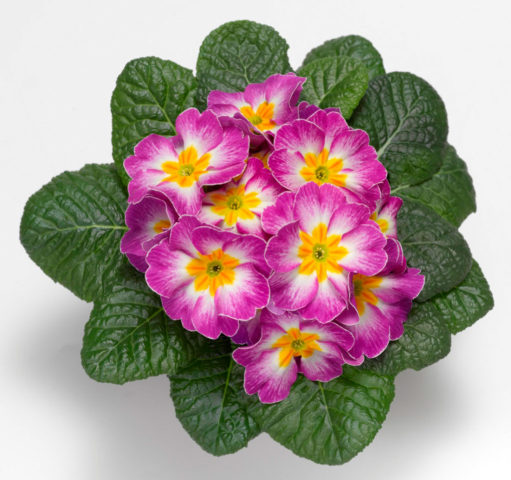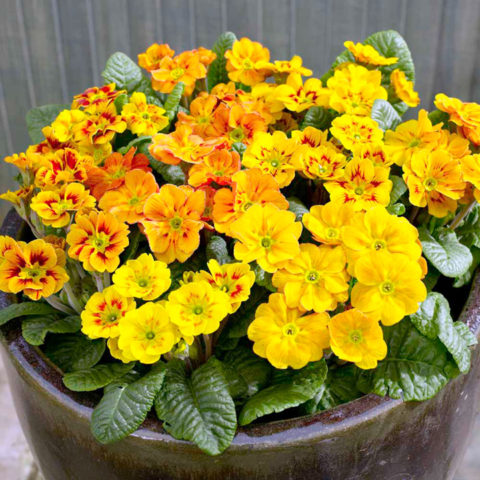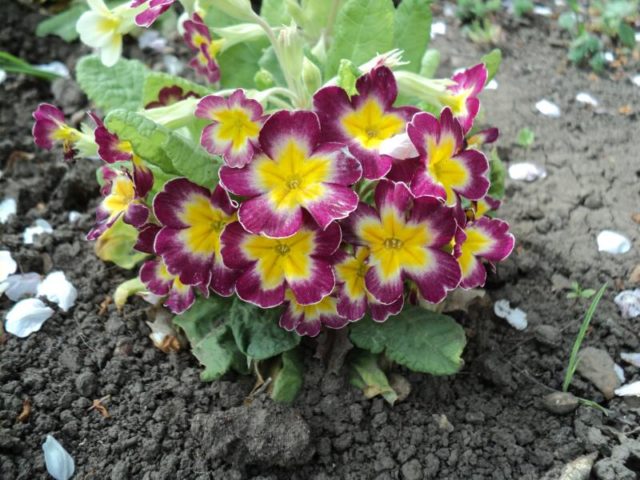Content
Primroses begin to bloom immediately after the snow melts, saturating the garden with incredible colors. Primula Akaulis is a type of crop that can be grown not only outdoors, but also at home. To achieve a long and beautiful flowering, it is necessary to recreate the conditions prevailing in the natural habitat of the primrose.

Primrose "Akaulis" - one of the earliest flowers in the garden
Description of primrose akaulis
Having once planted the primrose "Akaulis", the florist will be able to enjoy its flowering for more than one year. Blooming of buds begins at the very beginning of spring and lasts under ideal conditions until mid-summer. Bright flowers of various colors with contrasting centers appear on short, barely visible stems. Because of this, the second name of the species arose - stemless primrose. Flowers are collected in a neat bunch, surrounded by fluted pubescent leaves. In their place, boxes with seeds appear.
For growing on a personal plot, the seeds of stemless primrose are produced in the "mix" format. The result is a variegated multi-colored carpet. For home cultivation, seedlings or bushes of the desired color are usually acquired: white, yellow, red, blue, burgundy, lilac or pink. Primrose "Akaulis" is represented by varieties and hybrids with flowers of various shapes, including double ones.
Breeding features
Primrose is propagated in three ways:
- grown from seeds;
- share adult bushes;
- the leaves are cut and rooted.
Reproduction of primrose "Akaulis" by seeds is easier than long-stemmed varieties. Use purchased material or collected from their own bushes. In late autumn, direct sowing is carried out in open ground. Then they begin to grow seedlings in order to plant them in the garden in early spring. Sometimes primrose "Akaulis" is propagated by seeds for home conditions.
The process consists of the following steps:
- A shallow wide vessel is filled with a universal soil with the addition of vermiculite.
- Seeds "Akaulis" are sown into dry ground, sprinkled by 2 mm.
- Place the container in a bag and put it out in the cold (-10-15 aboutFROM).
- After a month, the container is placed on a windowsill without direct sunlight and the soil is moistened.
- Before the emergence of shoots, the mini-greenhouse is ventilated twice a day, and the temperature in the room is maintained at + 15-18 aboutFROM.
- With the appearance of sprouts, the temperature is raised to 20 aboutC and provide 10-12 hour daylight hours (in winter - with the help of additional lighting).
- When three leaves emerge, the seedlings are placed in separate pots and given standard adult primroses care.
Root dividing is the easiest and fastest way to breed a primrose. From a 2-3-year-old bush, a part is disconnected and planted, which has several sheets and long intact roots. A young plant is looked after in the same way as an adult specimen.
Cutting primrose "Akaulis" is carried out in the case when the bush has a weak root system and only one outlet.
The following sequence of actions is performed:
- A leaf with a growth point is separated from the root collar.
- Cut off its upper half.
- The leaf is planted in a container with peat and covered with glass or polyethylene.
- In the period before rooting (3-4 months), maintain the temperature + 16-18 aboutC, regularly ventilate and moisturize the substrate.
- With the appearance of several young leaves, the plant is planted in a permanent place.
Home care for primrose Akaulis
At home, the primrose "Akaulis" is grown in a pot, the diameter of which is equal to the height of the bush. It must have holes for water outflow. A drainage layer 3 cm thick is laid on the bottom. Soil, consisting of leafy earth, peat and sand, is poured on top. You can prepare it yourself or buy a ready-made universal mixture for indoor flowers.
It is important for primrose to create the right microclimate, otherwise it may refuse to bloom. The focus is on lighting, temperature and humidification. For intensive flowering, primrose "Akaulis" needs a regular supply of nutrients.
Microclimate
In order for the stemless primrose on the windowsill to feel good, you need to create optimal conditions for it. He loves soft, diffused light and cannot stand the direct rays of the sun in summer. Primrose "Akaulis" feels good in a cool room, and at high temperatures begins to fade. Ideally, if the thermometer does not show more than +15 aboutC. Drafts do not prevent primroses from developing, but hot streams from the heating system can be detrimental to it.

Primrose does not tolerate direct sunlight
Water is extremely important for Akaulis primrose. In addition to wet soil, the flower needs high humidity. It responds well to regular spraying with standing water during hot periods. After this, the leaves should not be too wet.
Watering and feeding
Moisturizing the primrose is based on the following principle - the topsoil should not dry out. It is from him that they are repelled, deciding how often and abundantly to water the bush in different parts of the growing season. Lack of moisture during the flowering period leads to the rapid wilting of the buds. Water is injected at the root, trying not to wet the leaves and flowers. In the summer, light spraying is carried out once a month.
Fertilization is necessary for primrose "Akaulis" throughout the growing season. Top dressing is regularly applied from February to October. Frequency - once every 2 weeks. The first time the fertilizer is applied before flowering. It is best to use complex mixtures that combine organic and mineral substances.
Transfer
Young primrose bushes "Akaulis" are transplanted into a new container as they grow. Usually such a need arises once a year. Mature shrubs are transplanted into a new pot every 3 years. It is selected so that it is 2-3 cm wider than the roots.
The algorithm of actions is as follows:
- Watering is stopped a week before the transplant.
- Dig up primrose, examine the roots, cut off the damaged parts.
- At the bottom of the new pot, 3 cm of drainage and a little soil are poured.
- The roots of the primrose are spread and covered with a substrate.
- Water the plant abundantly.
Growing primrose Akaulis in the open field
Only residents of the northern regions can afford to grow a primrose in sunny places of the garden, where the earth does not warm up much even at the height of summer. Basically, shady areas are chosen for him, for example, under the dense crowns of fruit trees. Various varieties of primrose "Akaulis" look great along the paths, near the pond and on multi-level flower beds. It is better to plant a group planting densely so that the leaves protect the roots from drying out. The soil for primrose should be light and moisture-absorbing.

In a single planting, the soil under the primrose dries quickly
A flower is planted in open ground in three ways:
- Seeds of primrose "Akaulis" are sown in moist soil - November or December.
- Seedlings, grown in advance at home or in a greenhouse, are planted - late February or early March.
- An adult plant is planted - immediately after flowering or in the fall.
When growing stemless primrose in the open field, it is important to adhere to the following recommendations:
- Choose shaded areas.
- Do dense group plantings.
- Mulch the soil.
- Do not allow the soil to dry out.
- Fertilize regularly.
Diseases and pests
In conditions of high humidity and hot air, fungal spores actively spread. Since the watering of the primrose "Akaulis" during the hot period cannot be reduced, you need to be ready to meet gray mold, black spot, rust or powdery mildew. It is best to arm yourself against them with Fundazol.
Primrose "Akaulis" is not often attacked by pests, but sometimes it can fall prey to weevils, aphids, spider mites or nematodes. Aphids are easily removed by hand. The hardest part is the fight against nematodes. They are insecticide resistant. In this case, the flower will have to be destroyed.
Conclusion
Primula Akaulis is an exquisite decoration for a suburban area and apartment window. When creating suitable conditions, the flower will delight the owner for a long time with a lush and bright flowering. The primrose is not afraid of frost, it resists disease well and is rarely affected by pests. The main reason for everyone's love for the Akaulis primrose is the early appearance of bright flowers that give a festive mood.








